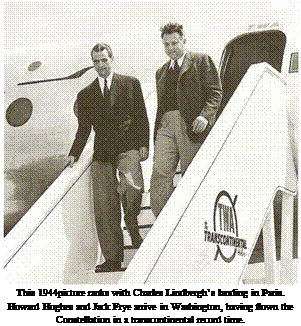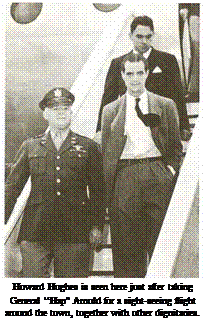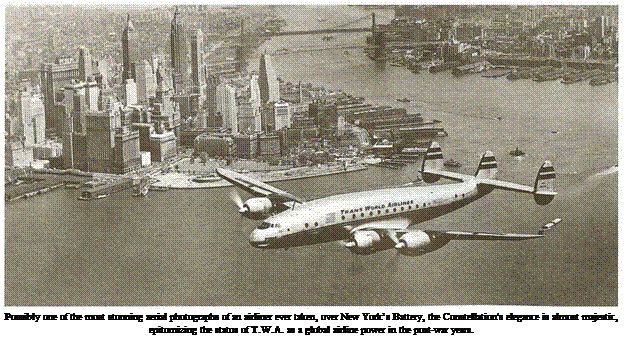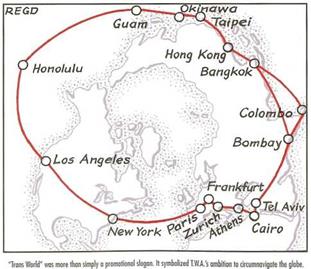Atlantic Service
Hughes Plays His Cards
The Boeing 307 Stratoliners had acquitted themselves well across the Atlantic during the War (page 46). But when they returned from the USAAF early in 1945, they were not suitable for long-range operations when fully equipped for commercial passenger use; and they were deployed on selected domestic routes until the Martin 202s replaced them in 1950. Before this, on 10 June 1944, T. W.A.—still at that time Transcontinental & Western Air—applied to the Civil Aeronautics Board for an ambitious, round-the-world network. Such ambition was typical of Howard Hughes. In 1938, he had already flown around the world (page 42) and he had flown the Constellation into Washington in 1944 (page 52). How much the authorities were influenced by this coincidence is unrecorded. Coincidence or not, on 5 July 1945, T. W.A. was awarded a handsome package of trans-Atlantic routes, and the Pan American overseas monopoly was broken.
Competition
In addition to the predictable ‘no-holds-barred’ opposition he could expect from Pan American’s Juan Trippe, another airline had entered the North Atlantic fray. American Airlines had bought American Export Airlines, formed during the War and operating flying boats under contract to the U. S. Navy. American Export became American Overseas Airlines (A. O.A.) which began the first post-war commercial scheduled trans-Atlantic flight by landplane, from New York to Bournemouth, England (London’s Heathrow Airport was not yet ready) on 24 October 1945.
Under a plan directed by the C. A.B., A. O.A. was authorized to serve northern Europe. Pan Am and T. W.A. were granted rights to several points in Europe, and onwards to India. Of the major destinations, Pan Am had the route to London, T. W.A. to Paris, and both could fly to Frankfurt.
In spite of Hughes’s and T. W.A.’s vigorous promotion of the Constellation, and with whose names it will always be most prominently associated, Juan Trippe and Pan American actually beat them into service. A T. W.A. Constellation made a proving flight to Paris on 25 November 1945, and took a party of specially-invited guests to the French capital on 3 December of that year. But when T. W.A. opened scheduled Constellation (Model 049) service on 5 February’ 1946, Pan American Airways had already stolen the thunder three weeks earlier, on 14 January, with its inaugural service to London.
DOUGLAS DC-4 FLEET
The subsequent rivalry ebbed to and fro, with Hughes and T. W.A. maintaining close cooperation with Ixickheed to produce a succession of improved versions of the Constellation. T. W.A. battled with Pan Ant’s Douglases and Boeing Stra- tocruisers for supremacy for many years, as is narrated in the following pages of this book. Hughes was against a formidable airline establishment, both at home and abroad.
The Second Line
T. W.A. still had a back-up fleet, which, fortunately, it did not need, at least not much. When the War was over, it took up its allocation of Douglas DC-4s which had been delivered to the USAAF as C-54 cargo planes. The fleet of 18 aircraft came to T. W.A. from February 1946 onwards (see fleet list on this page) and acted as a back-up for the Constellations. Three of them were the first, second, and fourth C-54s to be converted by Douglas back to civilian use.
Trans World
The Taj Mahal (named, perhaps, to symbolize T. W.A.’s extended route network in India) was the first to wear the marking “Trans World Airline.” The term soon came into general use, but was not officially registered as the name of the airline until 1950. A T. W.A. DC-4 was also the first to operate an all-cargo trans-Atlantic service, on 15 January 1947. Unpressurized, and outclassed by the Constellation, the four-engined Douglas DC – 4s continued as a second line to the Connies until 1964.
LOCKHEED 18-08 LODESTAR
|
The airline had applied to the CAB. for a round-the-world service os early as June 1944; but had to wait until the Pacific Route Case decision of early 1969 (see page 82) before completing the globe-circling route on 31 October 1971. Like other airlines, T. W.A. then found that many segments generated insufficient traffic, and the trans-Pacific and east Asian stations were closed down on 2 March 1975. |

![]()
 |
T. W.A. had been one of the five pre-war sponsors of the DC-4, had conducted a test program for the first C-54s off the line for the USAAF, and after the War took up its allocation of prewar orders (page 46). Often remembered is the DC-4’s lack of pressurization and its slower speed, compared with the Constellation. But production of commercial Connies was only just beginning in 1946, and C-54s were being converted into DC-4s at a faster rate. Also, the Lockheed airliner was not without its problems. Often forgotten is that, with the exception of T. W.A, B. O.A. C., Pan American, and Air France, seven airlines, mainly from Europe, introduced transAtlantic service before 1950 with DC-4s. Also, the C-54/DC-4s were the backbone of the Berlin Airlift in 1948/49, with more than 200 aircraft performing the greatest humanitarian airlift in history. One sturdy survivor is still making the rounds as a flying exhibition today.
|
Thia DC-4, pictured at Newark, was N45341, Taj Mahal. It was the first T. W.A. airliner to fly overseas, in 1946, wearing the marking Trans World Airlines. This name quickly came into use, although the corporate name was not changed until 1950. (Photo by Art Carter) |
TWA s ex-military DC-4s still had the C-54 s larger two-piece clamshell cargo doors. “Machat’s Law of Color Scheme Variation" is nicely shown here with a rearward-slanting cheatline leading edge. (Compare to photo).
Engines Pratt & Whitney Twin Wasp (1,450 hp) x 4 Length MGTOW 73,000 lb. Span
Max. Range 2,500 miles Height
|
|
THE WARTIME AIRLINERS COMPARED
















